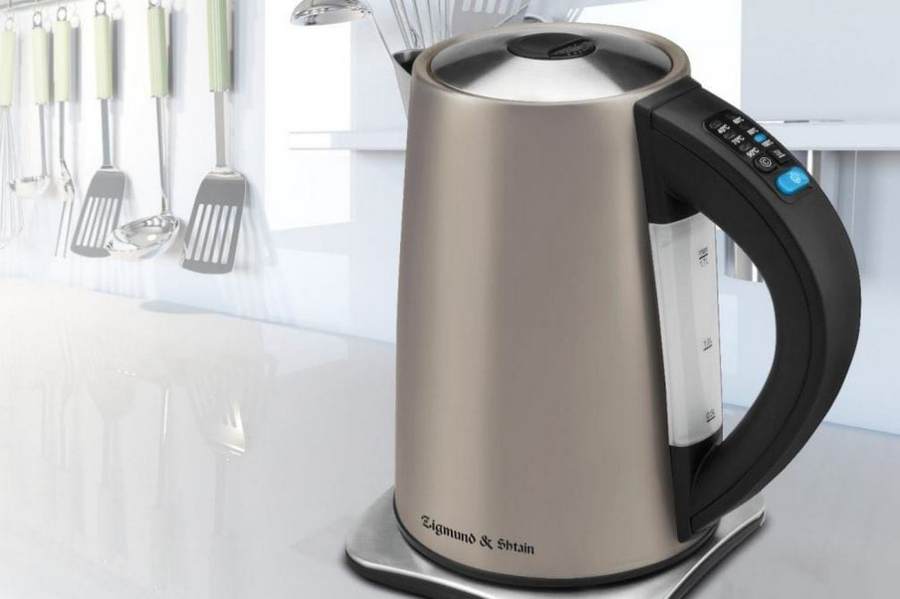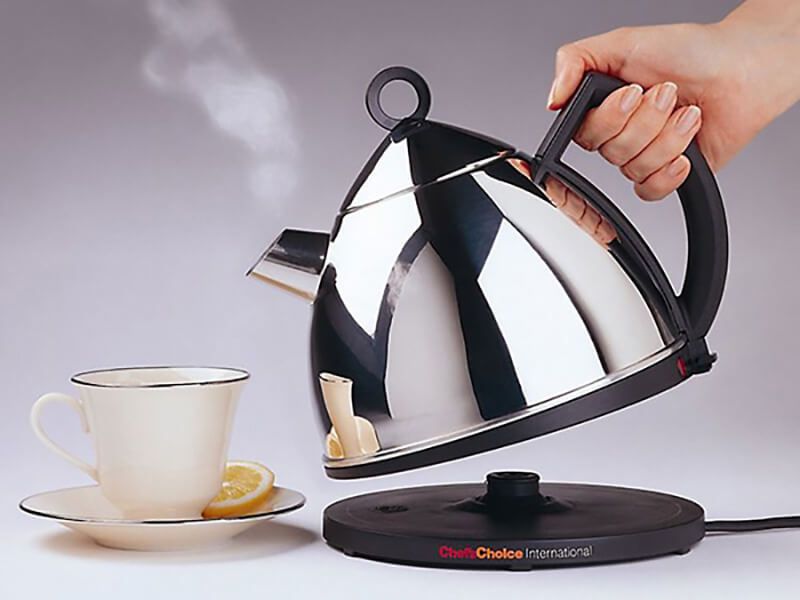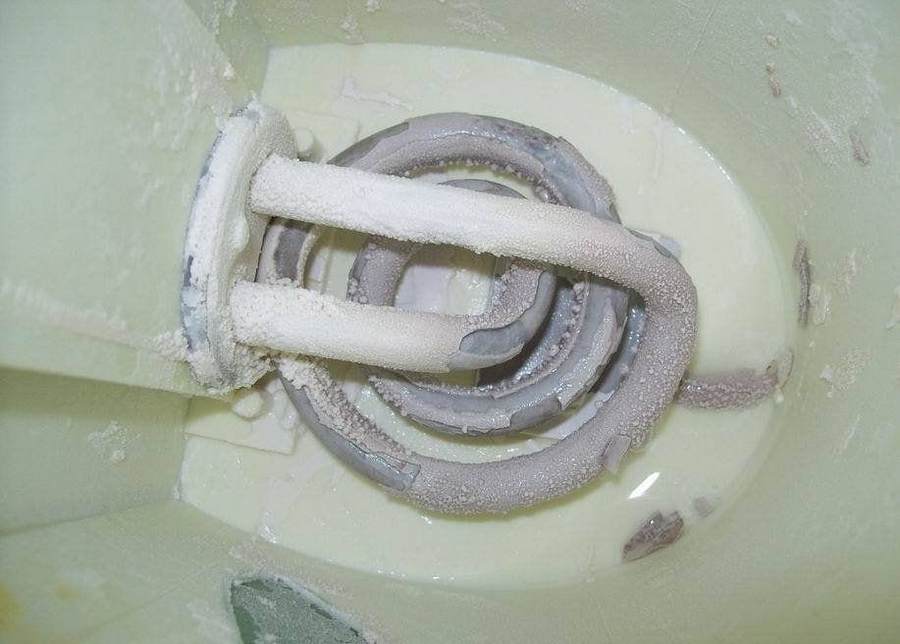Getting rid of limescale in an electric kettle
To use water from a kettle for drinking, the walls of which are covered with a layer of scale, is harmful to health, since some of the mineral salts settle in the internal organs. Therefore, cleaning the electric kettle is a vital necessity.
Salt and alkali deposits will be softened by an acidic environment. For a quick effect, boil in the presence of organic acids is connected.
Household
The advantage of ready-made mixtures is ease of use: they follow the instructions, follow the dilution scheme. Cons are in the chemical nature of the composition. Purchased products serve as a reason for the appearance of allergic reactions, worsen the air environment in the room.
- The list of household goods contains powders for getting rid of lime deposits based on phosphates, inorganic acids: Optimo plus, "Calgon", "Fresh", Frau Schmidt.
- Means "Anti-scale" differs from "Aqualon" in an improved formula with a reduced phosphate content, scale dissolves quickly. Affordable, economical in consumption.
- Descaler "Filtero" presented in liquid and free-flowing forms. Gently removes light plaque, effective in difficult hard deposits.
- Firm "Scamvon" manufactures compressed tablets for combating limestone. It is recommended to use the product for prophylaxis, cleaning surfaces, and removing sediment.
- Industrial acids are designed to prevent the formation of scale and remove plaque: formic, phosphoric. The creation of an acidic environment when flushing heating equipment avoids serious mineral deposits on the walls and spirals. In combination with periodic flushing, these methods give a lasting result.
Folk
Methods for cleaning with vinegar, citric acid, boric solution have become widespread due to their efficiency and economy. The components are readily available from your local hardware store or pharmacy.
- Prepare the composition: distilled water - 1 liter, vinegar essence 3-5 tablespoons. Pour acid into water, cover the heating element completely with liquid, leave in solution for 40-60 minutes.
- Lemon juice resists minor deposits: 2 tablespoons are applied directly to the surface to be cleaned, washed off with running water after 10–20 minutes.
- The hardened layer will be removed by boiling with lemon: two citruses will be used for a kettle from 1 to 2 liters. Cut into 4 parts in a separate container, manually squeeze the juice, transfer the entire contents, together with the zest, into the vessel to be cleaned. Add water to the upper mark, bring to a boil, leave to cool. Brush off softened plaque.
- Crystalline citric acid resists scale: diluted in the proportion: 60 g of lemon per ½ liter of boiled water at room temperature. Stir until completely dissolved. The problem parts are immersed in the solution for 10-12 hours or boiled for 20 minutes.
- Soda will help soften lime deposits: ½ pack of sodium bicarbonate is diluted in a liter of boiling water. Pour the surface to be cleaned. After 30 minutes, remove the deposits mechanically using a brush.
- Potato, apple, pear peelings also contain acid and starch: the mixture is brewed right inside the kettle. Insist for at least 30 minutes. Wash off with clean water, removing plaque.
- The brine after vegetables is rich in organic acids, it is not necessary to dilute: problem areas are poured, heated in a vessel or preliminarily, they wait until they cool completely. Remove the softened sediment.
- Cola or Sprite carbonated drinks will help remove scale. Method without heating: pour into the vessel to the level of the plaque layer, wait from 4 to 12 hours.
- Spoiled milk. The recipe for the most gentle cleaning: sour milk at an early stage without clot is poured into a kettle. Boil and allow to cool to room temperature. Drain the liquid along with the dirt.
Rules for cleaning a metal kettle
In order to efficiently remove scale from the walls of the metal, remember the rules:
- The best remedy is prevention.
- When cleaning, do not damage the surface of the material, leave scratches, chips. Salts and bacteria will settle in them, cleaning will take on a daily nature.
- No substances are added to the inside of the kettle that are not labeled "for kitchen and food equipment."
The new device is washed with clean water, rinsed, after a month they look at its internal state:
- Use descaling agents once every 7-10 days.
- Coarse bristled brushes are preferred over wire brushes.
- Coarse sponges should be used with caution.
- Abrasives are limited.

How to clean a metal kettle
Adequate care, timely cleaning, use of soft water - allow you to save energy, keep the device working for a long time. A certain algorithm will allow you to wash the scale in the electric kettle:
- Household appliances are disconnected from the network, cooled in a natural way.
- To quickly remove plaque inside the teapot, two approaches are used: mechanical and chemical. The first acts as an independent one or complements the second.
- For manual descaling, brushes made of artificial bristles, plastic, silicone, wood are used. It is important to clean the surface of the heating element in such a way as to remove plaque evenly and carefully. Residual deposits in the sections of the spiral will lead to uneven heating, energy waste, and burnout of the device.
- Do not wipe off deposits with sandpaper or a file, as there is a risk of damaging the metal surfaces. Layering in the process of further use will become more difficult to remove.
- The chemical method is understood as the use of acids, solvents for slag dilution. The measure, depending on the concentration of the solution, is of a regular preventive or urgent radical nature.
- The electric kettle is equipped with a mesh in the area of the spout, which is designed to retain the sediment from falling into the mug. The filter is washed regularly.
- At the end of each cleaning, boil the water twice, draining it. Rinse with a flowing stream to remove acid residues.

Preventing limescale and maintaining your kettle
The damage from lime sludge is difficult to overestimate:
- The harm to health is palpable.
- Increase in electricity consumption due to an increase in heating times.
- Breakage of the heating element.
- The device clicks off the button and boils the liquid.
- Drinks with cloudy water taste worse.
Prevention of the formation of limescale is known:
- High quality (filtered) water.
- Before boiling again, completely drain the leftovers from the kettle.
- Rinse the insides and filter mesh daily.
- They wash the walls with a sponge every morning.
- Clean once a month with a specialized product.
- Wash once a week in an acidic environment, rinsing thoroughly afterwards.

Why does scale appear
The main reason for the appearance of insoluble plaque is the presence of calcium and magnesium ions in a natural source. When boiled, hardness salts form lime deposits.
It is easy to wash off scale in an electric kettle. They carefully monitor the condition of the inner walls, clean the plaque in a timely manner, and prevent the sediment from transferring to stone.

